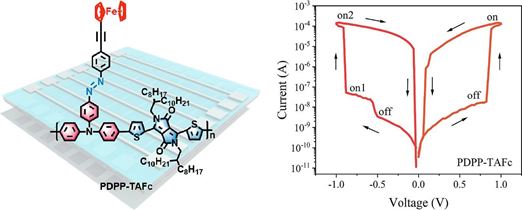Memristive behavior of ferrocene-functionalized polymer for artificial nociceptor application
Liu, Huiying ; Zhang, Miao ; Jiang, Minghao ; Han, Su-Ting ; Wong, Wai-Yeung
Chemical Engineering Journal • Published on 1 January 2025
Organic memristors have attracted widespread attention as highly promising candidates for implementing neuromorphic systems and wearable electronic devices. The donor–acceptor (D-A) polymers P1 and P2 are designed and successfully synthesized where the only disparity between the two polymers is the inclusion of a ferrocene (Fc) pendant group. The as-fabricated memristors Ag/P1/ITO and Ag/P2/ITO exhibit volatile threshold switching (TS) behavior, which is dominated by pseudo-bridging conductive filaments (CFs) depending on the diffusion dynamics of the Ag active metal species in the active layer. The more stable TS behavior of the P1-based memristor under a positive voltage sweep is attributed to the Fc units, which can reduce the random growth of CFs to some extent. The volatile ternary switching behavior in the negative working window can be attributed to the synergistic effect of Ag CFs and bilayer intramolecular charge transfer (ICT) process originated from two acceptor units of DPP2T and azobenzene groups. Moreover, the characteristics related to the application of the P1-based memristor on artificial nociceptors are demonstrated, including threshold, relaxation, no adaptation, and sensitization. This work demonstrated that leveraging the effect of constructing bilayer ICT mechanism represents an efficient strategy for building up multi-level memristors capable of versatile applications.



